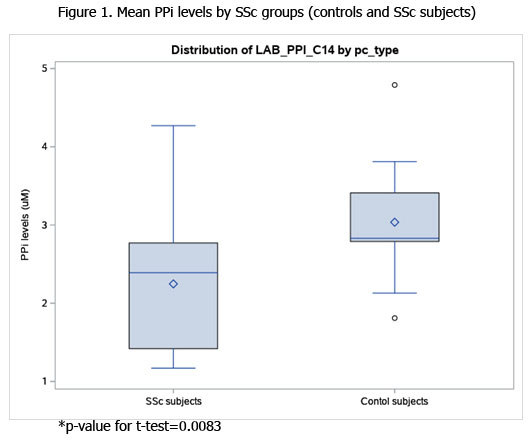Session Information
Session Type: Poster Session (Sunday)
Session Time: 9:00AM-11:00AM
Background/Purpose: Calcinosis cutis due to ectopic mineralization is a common and disabling complication of systemic sclerosis (SSc) that has poorly understood pathogenesis and no effective treatment. Inorganic pyrophosphate (PPi) is a key regulator of ectopic mineralization acting by inhibiting hydroxyapatite crystal growth (1,2). Ectopic mineralization has been attributed to low PPi levels in several genetic disorders such as pseudoxanthoma elasticum, generalized arterial calcification of infancy, and arterial calcification due to CD73 deficiency (3). Herein, we sought to test the hypothesis that reduced plasma PPi levels may be associated with SSc and play a pathogenic role in calcinosis.
Methods: Subjects meeting the 2013 ACR criteria for SSc (4) and age-matched controls without SSc were recruited from Rheumatology outpatient clinics for this IRB-approved study. Calcinosis was confirmed either by clinical criteria or by imaging. Levels of PPi in platelet-free plasma were measured by enzymatic reaction using 14C-labeled uridine-diphosphoglucose as substrate (5). Student T-test was used to compare mean PPi levels between control and SSc groups and linear regression to compare means between the 3 groups (control, SS-calcinosis and SSc-no calcinosis) with adjustment of potential confounders.
Results: We studied 33 subjects (19 control and 14 SSc, 5 of whom had SSc-calcinosis). In the SSc cohort, 60% had limited cutaneous SSc, as did 4 of 5 subjects with SSc-calcinosis. The mean disease duration (from non-Raynaud symptoms) was 18.7 (SD 8.7) years in SSc-calcinosis and 10.3 (SD 7.4) years in SSc-no calcinosis groups.
Figure 1 shows that the SSc cohort had significantly lower plasma levels of PPi (mean=2.25 uM vs 3.04uM, p=0.0083) compared to the control group (see Table 1, p for group difference= 0.0137). After adjusting for sex, the highest mean PPi levels were seen in the control group and the lowest in the SSc-calcinosis group.
Conclusion: Our findings indicate PPi levels are significantly reduced in SSc patients with calcinosis. The results suggest that PPi deficiency may be due to genetic or environmental influences that may be important in the pathophysiology of calcinosis, and could serve as a biomarker of the ectopic mineralization process. Larger clinical studies to confirm our findings are warranted.
References:
- Fleisch H. et al: Nature 1966; 212: 901
- Orris IR. et al: Curr Opin Pharmacol. 2016; 28:57
- Li Q. et al: Am J. Pathol. 2019; 189: 216
- Hoogen F. et al: Ann Rheum Dis 2013; 72:1747 and Arthritis Rheum. 2013; 65: 2737
- Li Q. et al: Cell Cycle 2014; 13: 2609
To cite this abstract in AMA style:
Hsu V, Schlesinger N, Li Q, Varga J. Reduced Circulating Levels of Inorganic Pyrophosphate Are Associated with Ectopic Calcification in Scleroderma Spectrum Disorders [abstract]. Arthritis Rheumatol. 2019; 71 (suppl 10). https://acrabstracts.org/abstract/reduced-circulating-levels-of-inorganic-pyrophosphate-are-associated-with-ectopic-calcification-in-scleroderma-spectrum-disorders/. Accessed .« Back to 2019 ACR/ARP Annual Meeting
ACR Meeting Abstracts - https://acrabstracts.org/abstract/reduced-circulating-levels-of-inorganic-pyrophosphate-are-associated-with-ectopic-calcification-in-scleroderma-spectrum-disorders/


